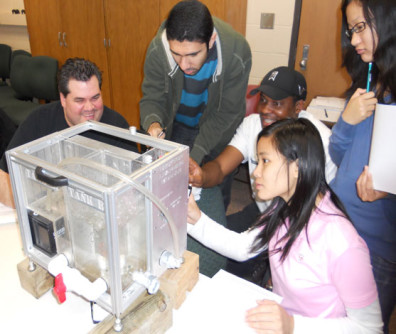We are in the Business of Learning
sue@susanweaver.net
Working to devise ways for engineering students to learn better, Baba Abdul, a PhD student in the Gene and Linda Voiland School of Chemical and Bioengineering, relates the basic premise of improving education to that of business—that we are here to serve the customer. “The student is the customer, and we’re in the business of educating,” he says.
Abdul is working with Bernard Van Wie, a professor in the Voiland School, in the area of engineering education. Van Wie’s team recently received a National Science Foundation grant to continue work on the development and use of a desktop learning module (DLM). The DLM, designed by PhD student Paul Golter, is a desktop apparatus with multiple, easily removable cartridges that can be reconfigured to perform experiments. Machinists from the WSU College of Engineering and Architecture Machine Shop were instrumental in helping design and construct the Desktop Learning Module.

Van Wie has been working since the late 1990’s to improve engineering education and to close the gap between how students learn and the way that engineering has traditionally been taught. In particular, he led a team of researchers in developing a curriculum based on Cooperative, Hands-on, Active, Problem-based Learning (CHAPL).
Professional educators have known for years about the benefits of using such learning approaches, and for engineering, hands-on learning is particularly important, says Van Wie. The typical student interested in engineering already tends to be better at learning while doing and at absorbing visual rather than verbal information. While non-lecture techniques have been commonly accepted and used at the elementary school level, they have been slow to be accepted in college, especially in engineering and the hard sciences.
Abdul, who grew up and attended college in Nigeria, remembers suffering through engineering classes that were taught in a traditional format. Professors would come into the classroom, tell students that none of them would receive an A, and then begin lecturing. “They didn’t help us to build our knowledge,” says Abdul.
Many students decided they couldn’t do engineering, and out of his class of 50 students at one of Nigeria’s top universities, only 20 graduated.
Out of the effort to develop an active curriculum, Van Wie uses the DLM for hands-on activities. In classes with the DLM, students learn to match the math they are learning with what is actually happening physically. So, for instance, the DLM contains a heat exchanger. Students conduct experiments to understand the concept of heat transfer between fluids. Understanding the concept of cross-flow and parallel flow can be confusing, says Abdul, but with the DLM, the students can see the difference between the two concepts and then learn to understand the equations “rather than just ‘plugging and chugging,’ ” he says.
The researchers have tested students’ understanding of concepts as they participate in hands-on and project-based learning. From evaluations, the researchers have found students prefer the hands-on activities and the projects that depend on understanding built during those activities.
“They feel that they’re doing real engineering,” says Abdul, “and the group work that they do simulates what happens in an engineering firm.”
The researchers found that working on team-based projects allowed students to learn valuable evaluation skills. The students actually rated themselves more harshly than professors and industry advisors did.
“The learning that happens is a complex learning experience that is focused and authentic,” says Abdul.
In the research, Van Wie’s team has shown that students using DLMs have shown statistically significant improvements in critical thinking skills and understanding of engineering concepts.
With the new grant, the researchers will be expanding use of the DLMs from its initial testing in a chemical engineering transport phenomena class into a variety of engineering classrooms, including civil, mechanical, bio- and even electrical engineering. In chemical engineering, the researchers will be trying out the DLM in thermodynamics and in a senior unit operations laboratory.
The DLM is being further used and tested in classes at five different institutions, ranging from a two-year college, to private four-year universities and a research university. The researchers also hope to begin working with industry partners to produce a commercial product. Recently, over the 2010 Christmas break the researchers successfully implemented the DLMs within a University of Oklahoma intersession class with Prof. Ed O’Rear, a collaborator from Oklahoma’s Chemical and Biomolecular Engineering Department.




